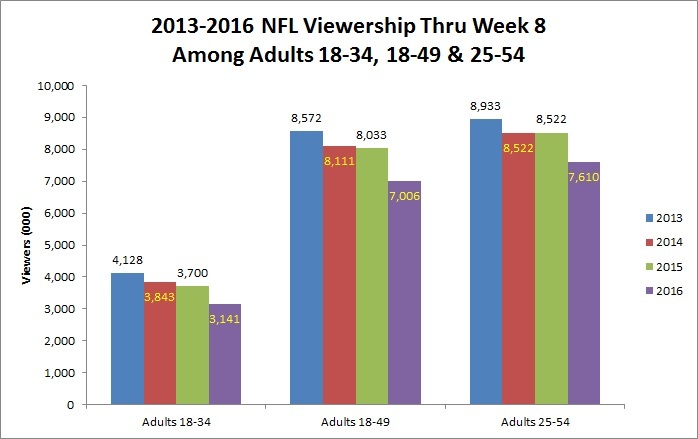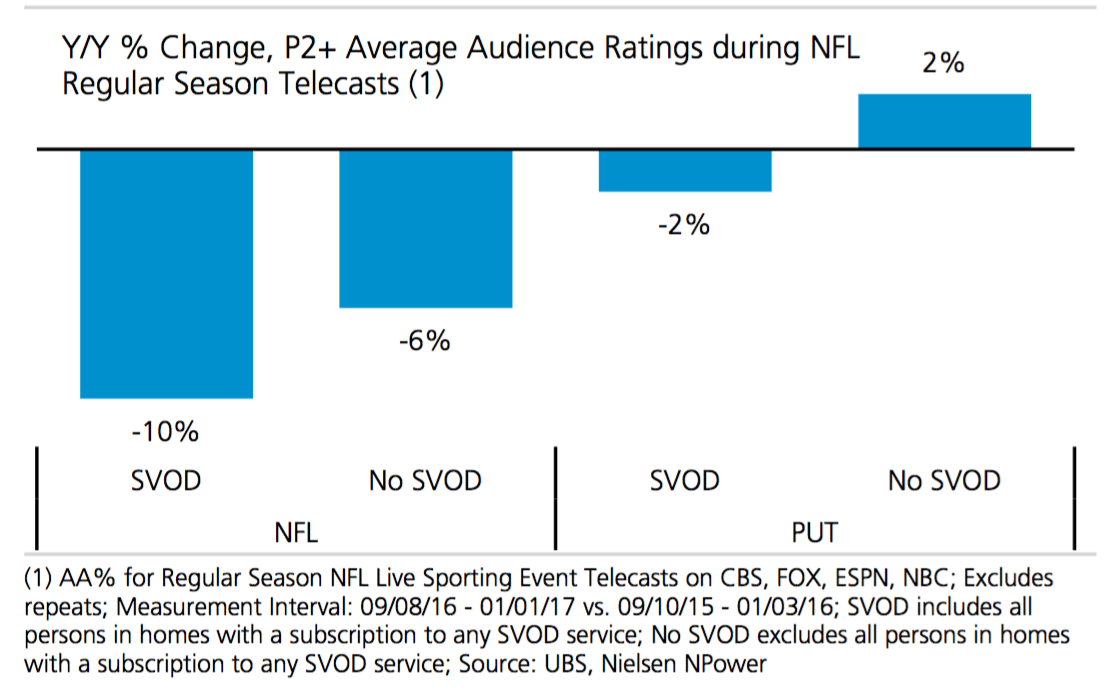Could the Rise of Digital Media Spell Doom for the NFL?

Streaming video on-demand services may be claiming a new victim, and a massive one at that: the multi-billion-dollar National Football League.
On-demand streaming services (such as Netflix, Hulu, and Amazon Prime Video) and media fragmentation may be claiming a new victim, and a massive one at that: the multi-billion-dollar National Football League.
The Most Dominant Professional Sports League
As the largest and most profitable professional sports league in the world (by a wide margin), the NFL raked in more than $13B in revenue in 2016 (Major League Baseball and the English Premier League came in second and third, with $9.5B and $5.3B, respectively) (1). The vast majority of that revenue comes from TV deals with various networks. In turn, the value of those deals is driven by the astronomical ad dollars TV networks stand to make from broadcasting NFL games.
Trouble Brewing
While the NFL has been historically (relatively) immune to the negative viewership trends affecting cable networks, 2016 started telling a different story. Overall, NFL TV viewership fell by 8% in 2016, the largest decline in 10 years (2). A more detailed look (Figure 1) shows viewership declining steadily over the past 3 years, across most adult age groups.

The NFL’s brain trust has directed its blame at the recent Presidential election, and the 24-hour news coverage it received. That is a reasonable (though inadequate) defense—NFL TV ratings have shown signs of recovery post-election (4). Yet, even since November 8th, TV viewership is still down compared to 2015. Sports and other pundits have come up with a slew of other explanations, including increased awareness of the NFL’s concussion and safety issues, an increase in incidents of domestic violence among NFL players, national anthem protests, declining star point, and declining level of play. While any of these factors could be playing a role, data points to another familiar suspect: video on-demand services.
Usual Suspects: Netflix and Co.?
We’ve all heard the story: millennials are cutting cords and moving away from traditional TV. The data is staggering; all age groups between 18 and 49 have shown a significant decline in time spent watching traditional TV since 2010, with the 18-24 age group being the most extreme, at -42% (Figure 2) (5).
Data goes on to establish a more direct link between the emergence of streaming video on-demand services (SVOD) and the decline in NFL viewership. A recent UBS report shows that NFL TV viewership has declined the most amongst SVOD subscribers (Figure 3). The appeal of SVOD services (over the NFL) could be attributed to a multitude of factors, including lack of ads, and the flexibility it affords customers to consume content at any time and at any place.


Keeping Up with a Changing World
Despite its immense popularity, the NFL realizes the need to adjust its value proposition and value capture models to keep up with changing consumer habits.
Back in 2008, the NFL debuted an internet TV service, NFL Game Pass, for users outside the United States. Aside from the ability to watch NFL games live from abroad, NFL Game Pass offers subscribers creative and attractive features, including the ability to watch and replay every game, replay condensed games (shrinking the average game to ~45 minutes, removing commercials, and time elapsed in between snaps), watch plays from various camera angels, and listen to local broadcasts. This service, however, is not available yet for live consumption in the United States due to existing contracts with Fox, NBC, ESPN, and CBS who air NFL games live.
Taking this experiment into the United States is likely to carry major risks. As explained above, the NFL’s current TV business model (which contributes most of the revenue) entails signing multiyear contracts with major TV networks, who in turn collect advertising dollars. Airing games through its own internet TV service would require the NFL to assume all the ad revenue risk, without the benefit of pricy long-term contracts with deep-pocketed networks. And aside from the financial risk, such an experiment is at least a few years away, as the NFL signed 9-year contracts with Fox, CBS, and NBC beginning in 2014 (7).
There has also been rumors that the NFL could license games to SVOD services, such as Netflix (although Netflix has not shown public interest in such a partnership yet). While these ideas may seem exciting and promising, they represent a stark pivot away from the traditional business model that has worked so successfully for the NFL in the past. Is the age of huge primetime viewership and 70+ ads per game over?
Sources:
- http://www.marketwatch.com/story/the-nfl-made-13-billion-last-season-see-how-it-stacks-up-against-other-leagues-2016-07-01
- http://nypost.com/2017/01/23/nfl-tv-viewership-fumbles-for-the-first-time-in-4-years/
- http://awfulannouncing.com/2016/the-nfls-ratings-are-down-but-just-who-exactly-isnt-watching-anymore.html
- https://www.wsj.com/articles/nfl-ratings-declines-ease-after-election-1483655875
- https://www.theatlantic.com/business/archive/2016/10/nfl-ratings-just-fell-off-a-cliff-why/503666/
- https://www.aol.com/article/finance/2017/01/12/the-rise-of-netflix-could-hurt-the-nfl/21653912/
- http://www.foxbusiness.com/features/2015/07/21/tv-deals-boost-nfl-revenue-to-new-record.html
- http://www.businessinsider.com/how-netflix-could-hurt-the-nfl-2017-1



I’m surprised that the NFL comes up as a loser in this space. They are among the first trailblazers to explore streaming their content on less conventional services, like Twitter and Facebook, and were the first to dabble in livestreaming their games on some of the realtime, livestreaming platforms. In addition, they’ve made a lot of advertising revenue from these platforms. Although Netflix might not be the best place for the NFL to take their content, do you think they could use other unsuspecting distribution platforms (Snapchat? Slack?) for their content and capture an even broader audience as a result?
Seems counterintuitive, doesn’t it? The lion’s share of the NFL’s revenue’s comes from TV deals (their most recent deals with Fox, NBC, and CBS pays $3B annually). So while their experiments with Twitter and other live streaming platforms may have been trailblazing, the revenues they brought in were rounding errors basically. If traditional TV suffers, the NFL will suffer.
I wonder if SVOD really offers much explanatory power, given that live sports has been the most resilient type of content in scheduled programming. The social nature of watching sports, combined with the experience of watching it live and the suspense over the outcome makes it a far less likely candidate for On-Demand consumption at a later time. Presumably there is increased live streaming of the games by people who no longer have cable, but doesn’t the NFL/TV networks have control over where it is streamed so that they can continue to collect revenue?
Yes, I agree. I don’t think that SVOD is really the reason behind the decline in viewership for the NFL this season. That argument doesn’t make sense to me because college football ratings have held constant, and you would expect both the NFL and college football to experience similar trends from the SVOD effect.
I think there are many other reasons why NFL viewership has suffered this season. The lack of stars (Tom Brady sitting out the first 4 games, Peyton Manning retiring) and lack of marquee / exciting games are likely more significant in explaining the drop off. For example, the Cowboys vs. Steelers game in Week 10 still drew high ratings because it was a good matchup and close game, but many nationally televised games were blow outs.
I think one of the key differences between the NFL and college football is that in the NFL, viewers generally have little interest in watching two teams play if the game is lopsided or they aren’t fans of either team (unless they are fantasy football players); in contrast, in college football, viewers are often excited to watch games between two teams that they aren’t fans of because they can always root for ranked teams to lose (and every game is important in determining who makes it into the college football playoff). I think to win in digital, the NFL needs to do a few things well: grow fantasy football, cultivate up-and-coming stars, and choose more exciting match ups or locally relevant games for nationally-televised slots. Another possible option is to allow fans to choose one team to follow on their digital platform NFL Game Pass and allow them to subscribe to access for all live games for that team, giving fans options to closely follow non-local teams.
I agree that SVOD doesn’t necessarily explain the whole story, but the other reasons that you brought forth have been soundly debunked — e.g. if you look at data (and advanced sports analytics), contrary to what many have said, quality of games, number of “stars”, number of marquee matchups, etc. have not changed compared to recent years. It’s probably a combination of various factors that’s causing this decline, some harder to prove with data than others.
Ali,
Not sure if you’ve seen it in your research, but Bloomberg Businessweek published a great cover article on this exact topic. https://www.bloomberg.com/news/articles/2016-11-03/nfl-was-a-sure-thing-for-tv-networks-until-now
Sports content is so valuable to content providers because it is one of the few remaining entertainment mediums which has a differential value when watched lived vs. watched recorded. Games are just much less exciting when you already know the outcome of the game, and the ease of access of highlight summaries from various sports networks as well as the NFL via its app and YouTube really lowers the value of watching a recorded game. Since SVOD can be consumed on demand while sports still mostly must be consumed live, the competition for viewership I would think would still tilt towards the NFL.
One culprit I do believe is having an impact is the growth of the NFL Redzone, unless my home team is playing in a game, I often find myself watching the Redzone channel instead of actual games; I find similar watching patterns in many of my friends who are casual football fans. It is a great consumer product; however, the expansion of Redzone’s appeal beyond the target market of the hardcore fantasy player has really hurt the overall ability of the league to generate revenue since any gains from increased subscriptions on Redzone are will be canceled out by lost advertising revenue from declining viewership from full games on major networks.
I also agree with Sijia’s point on the lack of compelling storylines explaining some of the NFL’s decline; many games lacked a compelling storyline or were notably one-sided – who really care about seeing the winless Cleveland Browns play a very mediocre Baltimore Ravens team?
I think one proving point for the value of a compelling storyline and good games is the 2016 season of the Dallas Cowboys. 5 of the 6 most viewed games of the 2016 NFL season involved the Dallas Cowboys; the Division Playoff game between the Dallas Cowboys and Aaron Rodgers’ Green Bay Packers was the most watched early-round NFL playoff game of all time with 48.5mm viewers. What made the Dallas Cowboys, who went 4-12 in 2015, to such high viewership numbers this season? – a compelling storyline. First, Dallas is a big market team which is known as “America’s Team” from its previous success. It’s starting quarterback, Tony Romo, went down during the preseason, but it was able to rely on two rookies Dak Prescott and Zeke Elliott to take them to a highly unexpected leading 13-3 record; hate them or love them, everybody wanted to watch to see if these rookies and this team would succeed or finally crash week after week. The Dallas-Green Bay game was full of exciting storylines – would Dallas finally overcome its troubles in playoffs, how would the rookies fair under the bright lights of their first NFL playoff game, would the “Bad Man” Aaron Rodgers, who led to an 8 game win streak after starting 4-6, be able to pull out another win? All these things led to ratings, ratings, ratings. The NFL is still relevant, despite its recent decline and threats from competing programming, but as long as it is able to find compelling storylines, keep relative parity in the league (i.e. see NBA’s Golden State Warriors), and make the most of its rising young stars (Cam Newton, Dak & Zeke, OBJ, etc.) I believe it will continue to be a highly valued and highly watched form of entertainment.